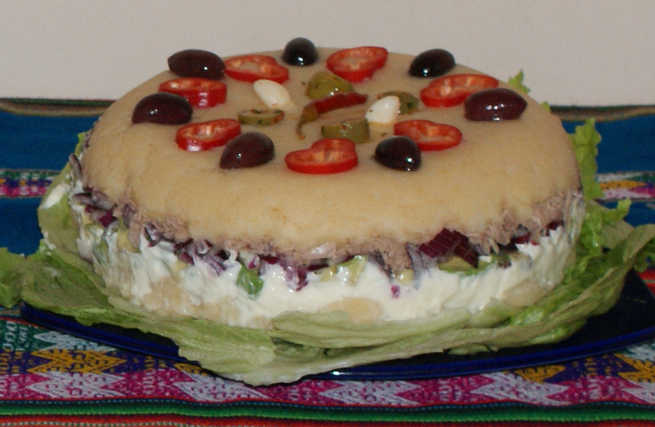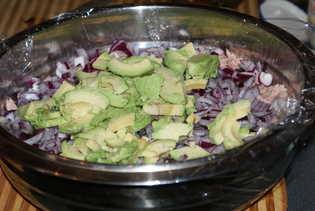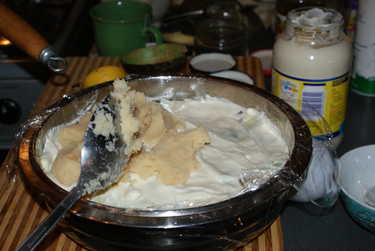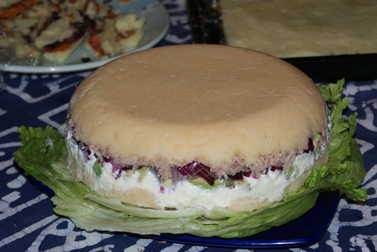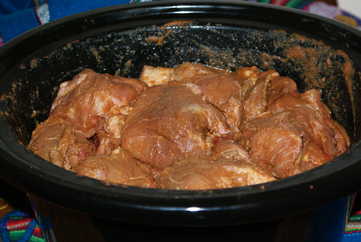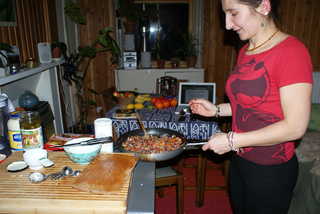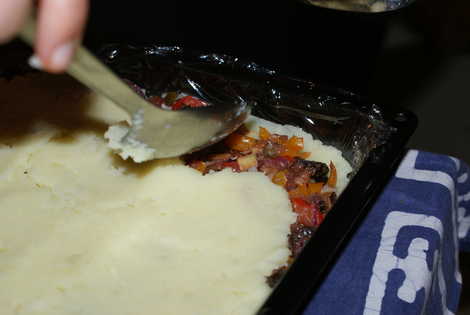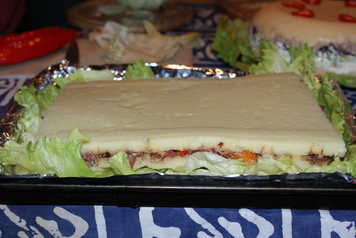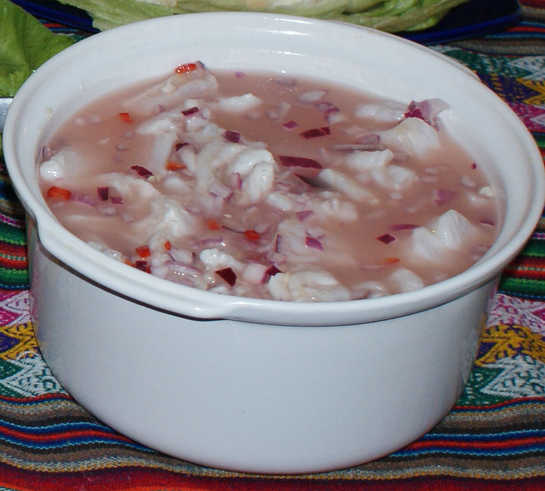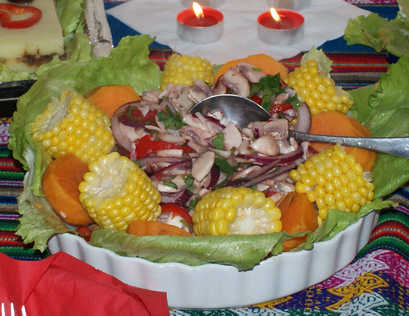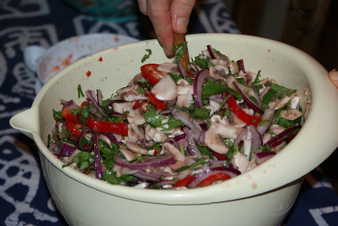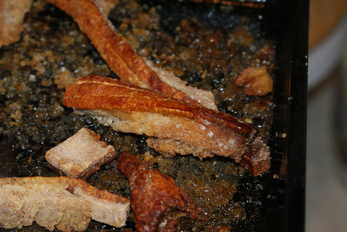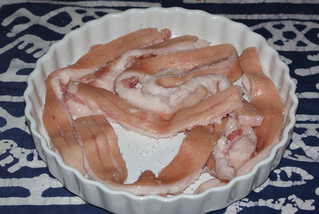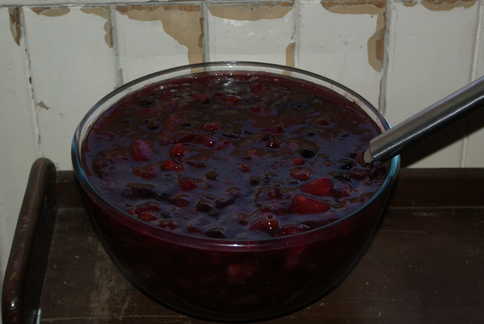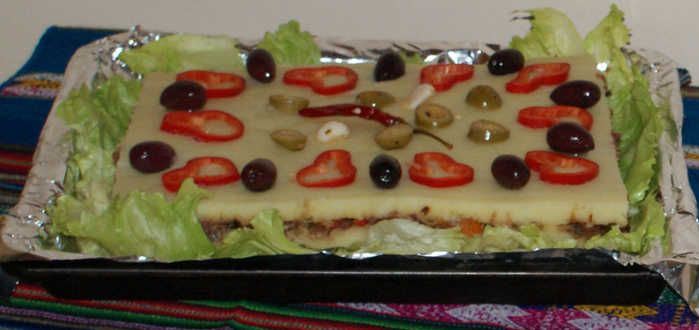
Peru Party
Dishes from our
Peruvian flat party to celebrate my cute landlady Aline finally getting her PhD.
Now she'll have to find herself a real job!
We made some of the dishes Aline and friends remember most fondly from their time up Peruvian trees examining mosses, with a little help from the interweb, Bryanna Clark Grogan's vegan conversions of Peruvian dishes and a pretty authentic-looking Peruvian cookbook with handy translations.
Now she'll have to find herself a real job!
Narrator: She never found herself a real job 😢
We made some of the dishes Aline and friends remember most fondly from their time up Peruvian trees examining mosses, with a little help from the interweb, Bryanna Clark Grogan's vegan conversions of Peruvian dishes and a pretty authentic-looking Peruvian cookbook with handy translations.
menu
Cold Courses
Mushroom Ceviche
Haddock Ceviche
Causa Rellana - vegan style
Quinoa Stew
Sweet Potatoes
Boiled sweet corn
Hot Stuff
Adobo de Chancho
Pork Crackling
Peruvian Rice
Pudding
Mazamorra morada
Picarones
Drinks
Pisco Sour
Mojitos
Mushroom Ceviche
Haddock Ceviche
Julia's contribution - and tons of it too!
Causa Rellana - with tuna fishCausa Rellana - vegan style
Quinoa Stew
Sweet Potatoes
Boiled sweet corn
Hot Stuff
Adobo de Chancho
Pork Crackling
Peruvian Rice
Pudding
Mazamorra morada
Picarones
The pudding which never happened.
Birthday Cake
Made using Clare's Gluten-Free Brownie recipe.
Drinks
Pisco Sour
Mojitos
The Peruvians eat everything with fat slices of sweet potato and chunks of corn on the side
(though their preferred variety has massive white kernels and isn't particularly sweet).
So we did our best.
To make your Peruvian Sweet Potatoes:
Just boil up the sweet potatoes in their skins in a large pan of water. Don't overcook them or they'll turn to mush - you can tell when a potato is ready because a knife will slip right in and out without you feeling the flesh gripping it. Drain them, then run under a little cold water and the skins will easily slide off. Slice them into fat rounds, about 2" wide.
Use them to decorate your Ceviche, or serve with the adobo.
And to make Peruvian-Style Rice:
It seems the Peruvians like a bit of garlic in their rice - about 1 tablespoon of chopped garlic per cup of rice. Just follow a standard absorption rice method using the garlic as your spice. Thoroughly wash the rice and let it drain, fry the garlic in oil until it begins to colour, add the rice and coat with the garlicky oil, then add 1⅓ times as much water or stock as you just added rice, season, simmer it up then cover and steam until it is ready.
Bob's your uncle.
To make your Peruvian Sweet Potatoes:
Just boil up the sweet potatoes in their skins in a large pan of water. Don't overcook them or they'll turn to mush - you can tell when a potato is ready because a knife will slip right in and out without you feeling the flesh gripping it. Drain them, then run under a little cold water and the skins will easily slide off. Slice them into fat rounds, about 2" wide.
Use them to decorate your Ceviche, or serve with the adobo.
And to make Peruvian-Style Rice:
It seems the Peruvians like a bit of garlic in their rice - about 1 tablespoon of chopped garlic per cup of rice. Just follow a standard absorption rice method using the garlic as your spice. Thoroughly wash the rice and let it drain, fry the garlic in oil until it begins to colour, add the rice and coat with the garlicky oil, then add 1⅓ times as much water or stock as you just added rice, season, simmer it up then cover and steam until it is ready.
Bob's your uncle.
Foolishly I followed a Peruvian recipe that had 1¼ times the volume of water as (washed) rice,
which was complete nonsense and produced rock hard rice.
I suppose the moral of that story is stick to what you know.
And what I (should) know is that you'll need 1⅓ times the amount of water as (washed) rice.
(And maybe slightly more for a very large pot of rice).
Causa Rellena
starter side fowl fish
A Peruvian potato, avocado and chicken (or tuna) terrine
This Peruvian signature dish is a bit of an odd mixture really.
But the moistened potato really sticks together well to give the whole thing its shape
and the avocado works brilliantly too.
Ours looked a tad messy with the mayonnaise layer leaking out everywhere - mixing the chicken/tuna or the onion with the mayonnaise first might keep things neater.
Ours looked a tad messy with the mayonnaise layer leaking out everywhere - mixing the chicken/tuna or the onion with the mayonnaise first might keep things neater.
Serves 6
Ingredients
- 1½ kg yellow potatoes
- juice from 3 lemons
- 2 tablespoons ground yellow chilli whatever that is - it must be pretty mild. ½ teaspoon of normal chilli powder does the trick!
- 1 finely chopped onion
- 1 chicken breast (cooked) we used 2 tins of tuna in brine
- 1 cup mayonnaise
- 1 avocado, sliced Or 3. Or 4
- a tablespoon or two of oil
- salt to taste
- lettuce, black olives, red chillies, parsley to garnish
- hard boiled eggs
Boil the potatoes in a pot with water and salt.
Peel the potatoes and mash them.
Mix the potatoes with the oil, chilli powder or grind up some fresh green ones if you prefer, lemon juice and salt until a compact, smooth mixture is achieved.
Place half the mixture in a rectangular dish (lining the dish with clingfilm will make it easier to turn out).
Place strips of chicken breast (or tuna fish) on top of the mixture and cover it with the onion and avocado, top it off with mayonnaise.
Use a suitably sized board or plate and with judicious use of more cling film, turn out the causa. We turned it out onto a bed of whole lettuce leaves.
Garnish the dish with the lettuce leaves, black olives, chopped parsley, boiled eggs and tomatoes.
Peel the potatoes and mash them.
Mix the potatoes with the oil, chilli powder or grind up some fresh green ones if you prefer, lemon juice and salt until a compact, smooth mixture is achieved.
Place half the mixture in a rectangular dish (lining the dish with clingfilm will make it easier to turn out).
Place strips of chicken breast (or tuna fish) on top of the mixture and cover it with the onion and avocado, top it off with mayonnaise.
You can also poach the chicken, then shred it and mix with the mayonnaise, and a little mustard too if you like.
Spread this out as your chicken layer.
Cover the chicken, avocado and onions with the other half of the potato mixture.Use a suitably sized board or plate and with judicious use of more cling film, turn out the causa. We turned it out onto a bed of whole lettuce leaves.
Garnish the dish with the lettuce leaves, black olives, chopped parsley, boiled eggs and tomatoes.
We served the causa on a bed of whole lettuce leaves and decorated with whole black olives,
large sweet chilli peppers sliced into rings and small pickled chilli peppers. But use anything else you fancy really.
It's actually pretty good, though I was a bit dubious at first.
A bit of a recipe melange.
Adobo de Chancho
main meat stew
Peruvian pork stew
Peruvian adobo recipes usually marinate the pork in either vinegar,
some sort of local hooch called chica de jora made from fermenting maize,
or possibly a dark beer.
The recipe I was (mostly) following also wanted 2 tablespoons of ground annatto, but I couldn't find any of that so I used a combination of saffron, paprika, beetroot powder and mango powder. It did cross my mind that pomegranate might have been nice, but another time perhaps.
Adding the fruit juice (and, to be honest, the wine) is a bit of a departure from the norm too, but I had some spare red wine, and I fancied a bit of fruity zing too.
The recipe I was (mostly) following also wanted 2 tablespoons of ground annatto, but I couldn't find any of that so I used a combination of saffron, paprika, beetroot powder and mango powder. It did cross my mind that pomegranate might have been nice, but another time perhaps.
Adding the fruit juice (and, to be honest, the wine) is a bit of a departure from the norm too, but I had some spare red wine, and I fancied a bit of fruity zing too.
Serves 6-8
Ingredients
- 4-5 lb pork, cubed
- 1 head garlic, peeled
- 2 teaspoons ground cumin
- large pinch saffron
- 2 teaspoons mild chilli powder
- 1 cup white wine vinegar
- teaspoon beetroot powder
- teaspoon amchoor
- 1/2 cup red wine
- juice 1 orange
- juice 1/2 lime
- dozen shallots, peeled
Peel the garlic and blend with the spices, saffron and a little vinegar to a paste, then add the remaining vinegar.
Cut the pork into generous 2" cubes.
Mix the meat with the spice mixture and leave to marinate for 12-36 hours.
Heat a layer of oil in a large frying pan or heavy shallow pot. Drain the meat and fry in batches until browned then transfer to a casserole or slow cooker.
Peel the shallots or small onions, fry them too in oil until caramelising and add to the pork.
Add the remaining marinade, some red wine and the fruit juice to the casserole to just cover the meat and cook slowly for a few hours until the meat is beautifully tender and the marinade has rendered to a thin stock.
Serve with peruvian rice turned out of a small bowl, and fat slices of boiled sweet potato.
Cut the pork into generous 2" cubes.
Mix the meat with the spice mixture and leave to marinate for 12-36 hours.
Heat a layer of oil in a large frying pan or heavy shallow pot. Drain the meat and fry in batches until browned then transfer to a casserole or slow cooker.
Peel the shallots or small onions, fry them too in oil until caramelising and add to the pork.
Add the remaining marinade, some red wine and the fruit juice to the casserole to just cover the meat and cook slowly for a few hours until the meat is beautifully tender and the marinade has rendered to a thin stock.
Serve with peruvian rice turned out of a small bowl, and fat slices of boiled sweet potato.
This was very well received, though personally I preferred Carne Adovada
for its fuller flavour.
Still the meat was very delicate - I cooked the stew on high in a slow cooker for about 4 hours, then turned it down low for another 4. Probably it would have been fine on low for the whole time.
Still the meat was very delicate - I cooked the stew on high in a slow cooker for about 4 hours, then turned it down low for another 4. Probably it would have been fine on low for the whole time.
Bryanna's Vegan Causa Rellena
side starter veg
A vegan version of a Peruvian potato, avocado and vegetable terrine
A vegan version of the traditional Peruvian Causa Rellena dish.
That manages to be a lot more complicated.
Serves 8
Ingredients
Lemon Dressing:- ½ tsp salt
- 2 small cloves garlic, minced or crushed
- ½ cup oil Aline used olive
- 2 Tbs extra-virgin olive oil
- 2 Tbs fresh lemon juice
Potato Layers:- 1 lb Russet potatoes
- 1 lb yellow potatoes, such as Yukon Golds or pink-fleshed potatoes
- 1 lb purple or blue potatoes
- Aline used 1.5kg red potatoes
- 10½ Tbs Lemon Dressing save the rest for the Filling
- 6 Tbs vegan mayonnaise such as Vegannaise Aline used normal mayo!
- ½ Tbs salt
Filling:- 1 Tbs olive oil
- 3 cloves garlic, minced
- 2 medium onion, thinly sliced
- 2 medium bell peppers (yellow, orange, and/or red), in thin strips
- 10 pieces sundried tomatoes in oil, squeezed to eliminate as much oil as possible, and thinly sliced
- 1 cup marinated artichoke hearts, drained and sliced thinly
- 2 Tbs pickled jalapeños minced
- the remaining Lemon Dressing
- salt and freshly-ground black pepper to taste.
Garnishes:- 2 large cobs of corn, cooked and cut into 1½" rounds these are used cold or at room temperature
- 1 large steamed or baked orange sweet potato, peeled and sliced in 6-8 pieces these are used cold or at room temperature
- 18-24 Peruvian Alfonso olives (or Kalamata olives)
Optional Garnishes:- Avocado cubes, tossed in lemon juice
- Roasted, pickled, or raw red bell peppers
- Pickled hot peppers
- Pretty lettuce leaves
To make the dressing:
With the back of a teaspoon in a small round-bottomed bowl (or use a medium-sized mortar and pestle), mash together the salt and garlic until it is like a paste. (The salt grains will help mash the garlic to a paste and the garlic juice will dissolve the salt.) Whisk in the Oil Substitute, olive oil and lemon juice, with a fork or small wire whisk.
This method of mixing is easy and convenient for small amounts made just before dressing the salad.
To make the potato layers:
Cook the three varieties of potatoes separately. You can peel and simmer the russet and the yellow potatoes (cut into even-sized chunks) in water to cover until just tender, but the purple or blue potatoes fall apart easily, so I steam or micro-steam them with the skins on. I cut them into about 2" pieces first. I micro-steam them for about 10 minutes.
To remove the skins of the blue or purple potatoes, hold them under gently-running cold water and the skins should slip off easily. Be careful not to saturate the potatoes with water.
Mash EACH separate batch of potatoes in its cooking pot or a bowl. When mashed, add to EACH batch of potatoes 3½ Tbs. of the Lemon Dressing, 2 Tbs. of the mayonnaise, and ½ tsp. of salt, and mash again until smooth. Reserve the remaining lemon dressing for the Filling. Set the mashed potatoes aside, covered.
To make the filling:
Heat the olive oil in a large nonstick skillet over medium-high heat. Add the onions, garlic, and peppers and saute until they soften. Add the sundried tomatoes, artichoke hearts, jalapeños remaining Lemon Dressing, mix well, and then taste for salt and pepper.
To assemble:
Line a 9x5" loaf pan, or a 10" round casserole with oiled plastic wrap, with an overlap. Press the one of the mashed potato mixtures onto the bottom of the pan. Add ½ of the filling, then another one of the potato mixtures, then the remaining filling, then the remaining potato mixture. Smooth the top, fold the overlapping plastic wrap over, and refrigerate for several hours or days.
To serve:
Fold back the plastic wrap covering the top of the terrine. Unmold the terrine Aline flipped the causa over using an appropriately-sized board onto a platter and garnish as desired.
With the back of a teaspoon in a small round-bottomed bowl (or use a medium-sized mortar and pestle), mash together the salt and garlic until it is like a paste. (The salt grains will help mash the garlic to a paste and the garlic juice will dissolve the salt.) Whisk in the Oil Substitute, olive oil and lemon juice, with a fork or small wire whisk.
This method of mixing is easy and convenient for small amounts made just before dressing the salad.
To make the potato layers:
Cook the three varieties of potatoes separately. You can peel and simmer the russet and the yellow potatoes (cut into even-sized chunks) in water to cover until just tender, but the purple or blue potatoes fall apart easily, so I steam or micro-steam them with the skins on. I cut them into about 2" pieces first. I micro-steam them for about 10 minutes.
To remove the skins of the blue or purple potatoes, hold them under gently-running cold water and the skins should slip off easily. Be careful not to saturate the potatoes with water.
Mash EACH separate batch of potatoes in its cooking pot or a bowl. When mashed, add to EACH batch of potatoes 3½ Tbs. of the Lemon Dressing, 2 Tbs. of the mayonnaise, and ½ tsp. of salt, and mash again until smooth. Reserve the remaining lemon dressing for the Filling. Set the mashed potatoes aside, covered.
Or you can do as Aline did, forget all that nonsense and just boil up 1.5kg of one kind of potatoes, mash them and add the dressing.
To make the filling:
Heat the olive oil in a large nonstick skillet over medium-high heat. Add the onions, garlic, and peppers and saute until they soften. Add the sundried tomatoes, artichoke hearts, jalapeños remaining Lemon Dressing, mix well, and then taste for salt and pepper.
To assemble:
Line a 9x5" loaf pan, or a 10" round casserole with oiled plastic wrap, with an overlap. Press the one of the mashed potato mixtures onto the bottom of the pan. Add ½ of the filling, then another one of the potato mixtures, then the remaining filling, then the remaining potato mixture. Smooth the top, fold the overlapping plastic wrap over, and refrigerate for several hours or days.
Or you can do as Aline did, forget all that nonsense and just press in a layer of potato, the filling then another potato.
To serve:
Fold back the plastic wrap covering the top of the terrine. Unmold the terrine Aline flipped the causa over using an appropriately-sized board onto a platter and garnish as desired.
Quite nice, though rather a lot of effort.
Fish Ceviche
starter main raw fish
Aline's friend Julia prepared this fishy ceviche.
She used haddock, which worked rather well I thought.
It's solid enough to hold together and has a strong enough flavour not to be overwhelmed by the marinade.
It's good to have the fish marinating for a couple of hours, but not for days - the fish starts to dissolve into the lime.
It's good to have the fish marinating for a couple of hours, but not for days - the fish starts to dissolve into the lime.
Serves 12
Ingredients
- 8 fillets of haddock, or any solid white fish
- juice of 15 limes
- 2 onions, chopped
- almost an entire head of garlic, minced
- 2 red chillies, minced
Cut the fish into cubes about 1" in size.
Cut the other ingredients as small as you like. Squeeze the limes, mix it all together and chill until required.
Tastes fine, good texture.
Mushroom Ceviche
side main raw veg vegan
Tiger milk is what they whoever they are call the ceviche marinade.
Presumably because it has a kick like a mule. Oh wait...
Serves 6
Ingredients
- 1 lb white mushrooms, chopped
- 3 garlic cloves, chopped
- 1 tsp salt
- 1/4 tsp black pepper
- 1 Bunch of fresh coriander, chopped
- ½ cup celery, chopped
- 1 Limo pepper, seeded and chopped whatever that is!
- juice of 8-12 limes
- 1½ red onion, thinly sliced and rinsed (save the heart)
- ½ red pepper, thinly sliced
- 1/4 Tsp ginger chopped
- 5 sweet potatoes, boiled, peeled and thickly sliced
- ½ lb corn, cut into pieces and boiled
Tiger Milk:
Blend celery, ginger, garlic, chile , salt, pepper, red onion heart and lime juice.
Ceviche:
In a large glass bowl mix mushrooms, red peppers, onions, coriander and Tiger Milk and let it sit for 5-10 minutes.
Serve the ceviche on top of lettuce leaves, with cold corn and sweet potatoes on the side.
Blend celery, ginger, garlic, chile , salt, pepper, red onion heart and lime juice.
Ceviche:
In a large glass bowl mix mushrooms, red peppers, onions, coriander and Tiger Milk and let it sit for 5-10 minutes.
Serve the ceviche on top of lettuce leaves, with cold corn and sweet potatoes on the side.
A reasonable alternative to fish, if you absolutely must.
Pork Crackling
side meat
You get the best pork crackling if you cut it off the pork joint and cook it separately,
that way you can get the oven hot enough without destroying your meat.
So first carefully peel the skin and most of the fat layer from the joint with a sharp boning or butcher's knife.
Now you can cut the skin into nice crackling slices - about ¾" wide and long enough to eat comfortably.
(If you're leaving the crackling on your joint and, on reflection, even if you're cooking it separately
then score the pork skin at about 1" intervals in a diamond pattern, cutting through the skin, but not into the meat or completely through the fat.)
I thought it might be nice to add a little vanilla flavouring to the crackling, and since I hadn't prepared any vanilla salt (apparently you can make it the same way you would vanilla sugar - by leaving a vanilla pod in your salt pot for a few weeks) I just scraped out the seeds from a pod and mixed them with the salt before rubbing the pork. It made no discernable difference :(
I thought it might be nice to add a little vanilla flavouring to the crackling, and since I hadn't prepared any vanilla salt (apparently you can make it the same way you would vanilla sugar - by leaving a vanilla pod in your salt pot for a few weeks) I just scraped out the seeds from a pod and mixed them with the salt before rubbing the pork. It made no discernable difference :(
Serves a dinner party
Ingredients
- the skin and fat from a nice pork joint
- salt - plenty of salt
Start working the day before you want your crackling -
reputable sources
say you need to salt the pork good and early.
Peel the skin and most of the fat layer off your pork joint as a big fat lardy slab.
Cut the skin into suitable crackling-sized pieces.
Rub your pork generously all over with a coarse sea salt as if into the face of your worst enemy as Fanny Cradock is reputed to have instructed. Leave the pork overnight in the fridge on layers of kitchen paper or in a colander. The salt will draw out quite a lot of moisture.
Next day take the pork out and pat it completely dry. Supposedly you might even use a hairdryer for this, though that seems like a pile of old pants to me. I did, though, leave the pork sitting in a warming oven for a while before starting to roast it.
You can rub in more salt if you think it needs it and the seeds from a vanilla pod if you want to try that out, and you've patted off all the salt you added earlier, but be aware - you can have too much salt!
Put the skin pieces on an oven tray - maybe on a rack in the tray so it doesn't wallow too much in it's own fat.
Now you're ready to start roasting - preheat the oven as hot as it will go, and stick in the crackling for 15 minutes, until it has started to, well, crackle.
Now turn the oven down to 180°C/Gas Mark 4 or so and leave the crackling until it is toasty golden and snaps like a Biafran's shin bone, another 30 minutes or so. Don't let it burn!
If your crackling still hasn't crackled you might be able to rescue it by grilling, or apparently even microwaving. Unlikely as that may seem.
Peel the skin and most of the fat layer off your pork joint as a big fat lardy slab.
Cut the skin into suitable crackling-sized pieces.
Rub your pork generously all over with a coarse sea salt as if into the face of your worst enemy as Fanny Cradock is reputed to have instructed. Leave the pork overnight in the fridge on layers of kitchen paper or in a colander. The salt will draw out quite a lot of moisture.
Next day take the pork out and pat it completely dry. Supposedly you might even use a hairdryer for this, though that seems like a pile of old pants to me. I did, though, leave the pork sitting in a warming oven for a while before starting to roast it.
You can rub in more salt if you think it needs it and the seeds from a vanilla pod if you want to try that out, and you've patted off all the salt you added earlier, but be aware - you can have too much salt!
Put the skin pieces on an oven tray - maybe on a rack in the tray so it doesn't wallow too much in it's own fat.
Now you're ready to start roasting - preheat the oven as hot as it will go, and stick in the crackling for 15 minutes, until it has started to, well, crackle.
Now turn the oven down to 180°C/Gas Mark 4 or so and leave the crackling until it is toasty golden and snaps like a Biafran's shin bone, another 30 minutes or so. Don't let it burn!
If your crackling still hasn't crackled you might be able to rescue it by grilling, or apparently even microwaving. Unlikely as that may seem.
Oh my yes!
Peruvian Quinoa Stew
main veg stew cheese
Apparently there is only one recipe in the world for Peruvian quinoa stew, and it's this one from the Moosewood cook book.
We know that because we looked at every single recipe in the webosphere answering to this description, and they were all the same. More or less.
Serves 4
Ingredients
- ½ cup quinoa
- 1 cup water
- 2 cups chopped onions
- 2 garlic cloves, minced or pressed
- 1 tablespoons vegetable oil
- 1 celery stalk, chopped
- 1 carrot, cut on the diagonal into ¼-inch thick slices
- 1 bell pepper, cut into 1-inch pieces or 1½
- 1 cup cubed zuchinni or 1 courgette, as Aline used. Since in this country we buy cubed zuchinni by the courgette.
- 2 cups undrained chopped fresh or canned tomatoes
- 1 cup water or vegetable stock
- 2 teaspoons ground cumin
- ½ teaspoon chili powder
- 1 teaspoon ground coriander
- Pinch of cayenne (or more to taste)
- 2 teaspoon fresh oregano or 1 teaspoon dried oregano
- Salt to taste
- Chopped fresh coriander (optional)
- Grated Cheddar or Monterey Jack cheese (optional)
Rinse the quinoa well with cold water. Use a fine mesh filter or coffee filter or you'll lose quite a lot into the sink.
Quinoa is coated with a natural substance called saponin that protects the
grain by repelling insects and birds. Rinsing the quinoa is important to avoid a
raw or bitter taste. You can tell if there is saponin by the production of a soapy
looking suds when the seeds are swished in water.
Good news! If you are using Ancient Harvest Quinoa you can skip this step. It's
already rinsed!
Place rinsed quinoa and water in pot (covered) and cook covered on medium-low heat for about 15 minutes until soft.
While the quinoa is cooking place the onions, garlic and vegetable oil in covered soup pot and saute on medium heat for 5 minutes.
And celery and carrots to the soup pot and cook an additional 5 minutes, stirring often.
Add the bell pepper, zucchini, tomatoes, and one cup water or vegetable stock to soup pot. Stir in cumin, chili powder, coriander, cayenne and oregano to soup pot simmer covered for 10 to 15 minutes until vegetables are tender.
Stir in cooked quinoa and salt to taste.
Top with grated cheese (and optionally chopped coriander).
Apparently, according to the author, there are people who simply hate coriander, and (s)he urges caution in its use. Fortunately I know of no such people.
Serve immediately.
Place rinsed quinoa and water in pot (covered) and cook covered on medium-low heat for about 15 minutes until soft.
While the quinoa is cooking place the onions, garlic and vegetable oil in covered soup pot and saute on medium heat for 5 minutes.
And celery and carrots to the soup pot and cook an additional 5 minutes, stirring often.
Add the bell pepper, zucchini, tomatoes, and one cup water or vegetable stock to soup pot. Stir in cumin, chili powder, coriander, cayenne and oregano to soup pot simmer covered for 10 to 15 minutes until vegetables are tender.
Stir in cooked quinoa and salt to taste.
Top with grated cheese (and optionally chopped coriander).
Apparently, according to the author, there are people who simply hate coriander, and (s)he urges caution in its use. Fortunately I know of no such people.
Serve immediately.
Really not too bad. For quinoa!
Bryanna's Mazamorra Morada (Peruvian Purple Corn Pudding)
dessert veg vegan
Peruvian fruit and purple corn cold pudding
This pudding is traditionally made with purple corn and sweet potato starch.
Here Bryanna has ingeniously substituted blueberries for the colour and cornstarch for the thickener.
I can't speak to its authenticity, but somehow it had a South American quality to it.
Might be the fruity cinnamon.
Aline tells me this goes very nicely with rice pudding.
Might be the fruity cinnamon.
Aline tells me this goes very nicely with rice pudding.
Serves 12
Ingredients
Ingredients A
- 2 cups frozen small blueberries, defrosted
- 3 cups water
- 1½ cups sugar
- 1 stick cinnamon
- 4 cloves
- 12 dried prunes, chopped
- 6 dried apricots, chopped
- ⅓ cup golden raisins
- 1 large apple, peeled and chopped
- Grated zest and chopped flesh of 1 large organic orange
- Zest of 1 small organic lime and 1 small organic lemon
Ingredients B
- 1 cup cold water
- 6 Tbs cornstarch
Ingredients C
- 1 x 19 oz. can unsweetened pineapple chunks, well-drained
- 2 Tbs lime juice
- 2 Tbs lemon juice
Mix ingredients A in a large Pyrex bowl and microwave on high for 10 minutes.
Or, simmer the mixture in a large non-aluminum pot for 15 minutes.
(Wrap the cloves and cinnamon in a square of cheesecloth and tie with string.)
Remove the cheesecloth bag after cooking.
Mix ingredients B together well and stir into hot A mixture. Microwave on high for 3 minutes, stir well, and cook 3 minutes more. It should be thick and clear.
Or, stir B into A briskly and stir over medium-high heat until thickened and clear.
Stir in ingredients C and spoon into serving dishes. Cover with plastic wrap and chill until serving time. It should be cold and pudding-like.
Mix ingredients B together well and stir into hot A mixture. Microwave on high for 3 minutes, stir well, and cook 3 minutes more. It should be thick and clear.
Or, stir B into A briskly and stir over medium-high heat until thickened and clear.
Stir in ingredients C and spoon into serving dishes. Cover with plastic wrap and chill until serving time. It should be cold and pudding-like.
Quite evocative, though I probably wouldn't eat much of it. But then I'm not big on puddings.
Picarones
dessert veg
Peruvian for doughnuts!
This classic Peruvian dessert is a supposedly highly addictive take on the American doughnut.
I didn't get around to making it yet, so I can't say, but anything made of deep-fried carbohydrates has my approval!
Serves 6
Ingredients
- 250g pumpkin or butternut squash
- 250g sweet potato
- 2 cinnamon sticks, 2 teaspoons anise seeds, 1 teaspoon cloves optional
- ⅛ cup pisco optional
- 250g wheat flour
- 1 tablespoon yeast
- 1 tablespoon sugar
- 1 tablespoon corn flour
- ½ cup milk
- lard or oil for deep-frying
Syrup:- 750g chancaca or unrefined cane sugar/molasses
- 2 cups water
- peel of 1 orange
- 1 cinnamon stick
- peel of a couple of limes optional
- 1 dry red chilli optional
- a few cloves optional
Make the syrup:
Combine the chancaca or molasses with the water, peels and spices in a small pan. Some recipes also add the fruit juice. Bring to the boil, then simmer for 15 minutes or until the mixture thickens slightly, like pancake syrup. Strain to remove the spices, and set aside to cool (it will thicken more as it does so).
Make the doughnuts
Bring a large pot of water to the boil, and add the spices if using. Peel the sweet potatoes and pumpkins and cut them into chunks. Add them to the water and cook until soft. Remove and drain; the pumpkin first as it will cook faster.
Mix in a blender adding milk a little at a time.
Add the pisco if using.
Add the wheat and corn flour.
Add the yeast and sugar.
Make a consistent pastry and place it in a deep dish and knead for 5 minutes or so to a soft well-blended dough. It should be stretchy and smooth, but sticky. Add more flour if it is very liquid.
Leave it to stand for a couple of hours or so until it doubles in volume.
When the dough has risen, heat the oil in a pot to 350°F.
Wet your fingers in salted water. Form the doughnuts by grabbing a small handful of dough and stretching it into a ring around around a couple of fingers, then tossing the dough quickly into the oil. Cook briefly, 20 seconds or so, and then flip the doughnuts using the handle of a long wooden spoon.
Cook the doughnuts in the oil until they are golden brown (about 30 seconds longer), then remove them to a paper towel lined plate.
Serve immediately, drizzled with the warm syrup.
Combine the chancaca or molasses with the water, peels and spices in a small pan. Some recipes also add the fruit juice. Bring to the boil, then simmer for 15 minutes or until the mixture thickens slightly, like pancake syrup. Strain to remove the spices, and set aside to cool (it will thicken more as it does so).
Make the doughnuts
Bring a large pot of water to the boil, and add the spices if using. Peel the sweet potatoes and pumpkins and cut them into chunks. Add them to the water and cook until soft. Remove and drain; the pumpkin first as it will cook faster.
Mix in a blender adding milk a little at a time.
Add the pisco if using.
Add the wheat and corn flour.
Add the yeast and sugar.
Make a consistent pastry and place it in a deep dish and knead for 5 minutes or so to a soft well-blended dough. It should be stretchy and smooth, but sticky. Add more flour if it is very liquid.
Leave it to stand for a couple of hours or so until it doubles in volume.
When the dough has risen, heat the oil in a pot to 350°F.
Wet your fingers in salted water. Form the doughnuts by grabbing a small handful of dough and stretching it into a ring around around a couple of fingers, then tossing the dough quickly into the oil. Cook briefly, 20 seconds or so, and then flip the doughnuts using the handle of a long wooden spoon.
Cook the doughnuts in the oil until they are golden brown (about 30 seconds longer), then remove them to a paper towel lined plate.
Serve immediately, drizzled with the warm syrup.
Pisco Sour
drink raw veg
Peruvian Pisco cocktail with whipped egg whites
Pisco is a Chilean/Peruvian grape brandy,
According to my egg-sacting interweb searches, the salmonella occasionally found in eggs is unlikely to grow in the whites,
preferring the meaty goodness of the yolks, so you should be pretty safe drinking these.
I'd probably still go for free-range certified eggs if you can though.
Serves One
Ingredients
- 2 oz peruvian pisco
- 1 oz lemon juice though I believe that what the Peruvians call lemon is actually a variety of Persian lime
- 1 oz syrup
- 1 egg white (which is about 1 fl oz)
- 3 ice cubes
- A dash of Angostura bitters or a sprinkle of cinnamon
Mix the pisco, lemon juice, syrup and ice cubes with the egg whites in a shaker or a blender.
Blend well and serve in a wine glass.
Decorate with 4 sprinkles of angostura bitters or cinnamon.
Blend well and serve in a wine glass.
Decorate with 4 sprinkles of angostura bitters or cinnamon.
Smooth and creamy - they seemed popular, though they sat pretty heavily on my tummy.
If you add passion fruit juice then it becomes a Maracuyà sour!
If you add passion fruit juice then it becomes a Maracuyà sour!
I froze some leftover sour to see if it would make a nice sorbet.
It didn't really, bit too alcoholic, but not so alcholic that they froze smoothly :(
It didn't really, bit too alcoholic, but not so alcholic that they froze smoothly :(
